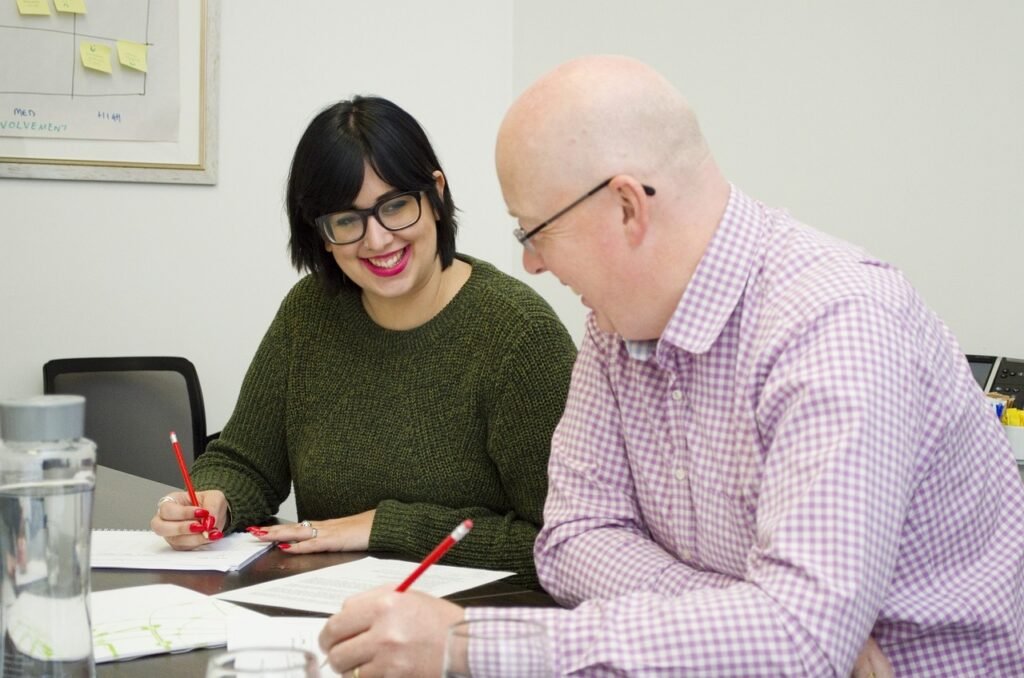
Introduction to Being Assertive

Being assertive is a vital communication skill that enables you to express your thoughts and feelings openly while maintaining respect for others.
It’s a balanced approach where you can stand up for yourself without crossing the line into aggression.
Often, people misunderstand assertiveness, thinking it equates to being pushy or domineering.
However, true assertiveness is about being honest and direct, fostering an environment where open dialogue is welcomed.
Imagine you’re in a meeting, and you have a differing opinion.
An assertive person would confidently voice their perspective, ensuring their voice is heard while also being considerate of others’ viewpoints.
This creates a space where everyone feels valued and heard, promoting more effective and collaborative communication.
Assertiveness is not just about verbal communication; it also includes non-verbal cues such as body language, eye contact, and tone of voice.
These elements work together to convey confidence and clarity.
For instance, maintaining eye contact and an upright posture can significantly enhance how your message is received.
Developing assertiveness can also enhance your emotional well-being.
By communicating your needs and setting clear boundaries, you reduce the likelihood of misunderstandings and conflicts.
This leads to healthier relationships, whether at work, at home, or in social settings.
Another critical aspect of assertiveness is the ability to say no.
Many people struggle with this, fearing they will disappoint others or appear uncooperative.
However, saying no when necessary is essential for maintaining balance and avoiding overcommitment.
Assertiveness empowers you to make choices that are in your best interest while respecting others’ needs.
In the following sections, we will delve into practical exercises to help you develop these crucial skills.
Advantages of Assertiveness Training

Training in assertiveness offers a multitude of benefits that can transform various aspects of your life.
In the workplace, being assertive helps you communicate your ideas more clearly and confidently, leading to better collaboration and productivity.
It ensures that your contributions are recognized, which can open doors to new opportunities and career advancement.
On a personal level, assertiveness fosters healthier and more balanced relationships.
When you express your needs and feelings openly, it sets a foundation for mutual respect and understanding.
This clear communication reduces misunderstandings and minimizes conflicts, creating a more harmonious environment.
Additionally, assertiveness training can significantly impact your emotional and mental health.
By advocating for yourself and setting appropriate boundaries, you decrease the likelihood of feeling overwhelmed or taken advantage of.
This can lead to lower stress levels and a greater sense of control over your life.
Learning to be assertive also enhances your self-esteem and confidence.
As you practice these skills, you’ll begin to see the positive effects of your improved communication, reinforcing your belief in your own abilities.
This growing confidence can spill over into other areas of your life, making you more willing to take risks and pursue your goals.
Lastly, assertiveness helps you develop better problem-solving skills.
When you approach situations assertively, you’re more likely to address issues head-on and find effective solutions.
This proactive mindset not only resolves conflicts more efficiently but also fosters a more constructive and positive atmosphere in all your interactions.
Activity 1: Engaging in Role-Playing
Role-playing serves as a valuable exercise for honing assertive communication skills in a controlled, risk-free setting.
To get started, pinpoint specific scenarios where you typically find it difficult to be assertive.
This could range from asking for a raise at work to setting personal boundaries with a friend.
Once you’ve identified these scenarios, partner with a friend, family member, or colleague who can play the role of the other party involved.
Clearly explain the context and your goals for the exercise.
During the role-play, focus on articulating your thoughts and feelings directly and respectfully.
For example, if you’re practicing how to request more time to complete a project, you might say, “I need an additional week to ensure the quality of my work,” rather than, “You always give me impossible deadlines.”
Throughout the role-play, pay attention to your body language and tone of voice, as these non-verbal cues significantly impact how your message is received.
Maintain eye contact, stand or sit upright, and speak in a calm, steady tone.
After the role-play session, take some time to reflect on the experience.
Discuss with your partner what felt natural and what seemed challenging.
This feedback can provide valuable insights into areas where you may need more practice or adjustments.
Repetition is key to mastering assertiveness.
As you become more comfortable with role-playing, try incorporating more complex or emotionally charged scenarios.
This progressive approach allows you to build confidence and adaptability in various situations, enhancing your overall assertiveness skills.
Activity 2: Implementing ‘I’ Statements
‘I’ statements are fundamental to assertive communication as they help you express your feelings and needs without placing blame on others.
This technique involves speaking from your own perspective, which promotes clearer and more respectful dialogue.
Instead of saying, “You never listen to me,” which can come across as accusatory, you could say, “I feel unheard when my suggestions are overlooked.”
This subtle shift in language helps to foster understanding and reduces defensiveness in the conversation.
To practice using ‘I’ statements, start by identifying situations where you typically feel challenged.
Write down how you would normally express your feelings and then reframe those sentences to begin with “I.”
For example, if you often feel frustrated when colleagues interrupt you, instead of saying, “You always cut me off,” try, “I feel frustrated when I’m interrupted because I lose my train of thought.”
When crafting ‘I’ statements, focus on three key components: the behavior, the effect it has on you, and your feelings.
This structure helps you convey your message clearly and assertively.
For example, “When meetings start late (behavior), I feel stressed (feeling) because it disrupts my schedule (effect).”
Practicing ‘I’ statements can initially feel awkward, especially if you’re used to a more passive or aggressive style of communication.
However, with time and repetition, this approach will become more natural.
Try using ‘I’ statements in low-stakes situations to build your confidence before applying them in more challenging interactions.
Incorporating ‘I’ statements into your daily communication can greatly enhance your ability to assert yourself while maintaining positive relationships with others.
Activity 3: Establishing Boundaries
Boundaries are essential for maintaining your well-being and assertiveness.
Start by reflecting on different areas of your life where you need to set limits, such as work, relationships, and personal time.
Clearly define what is acceptable and what isn’t for you in these contexts.
Once you have identified your boundaries, communicate them openly and respectfully.
For instance, if you require focused time to work without interruptions, you could say to your colleagues, “I need to focus on this task without interruptions for the next two hours.”
This direct approach helps others understand your needs and fosters respect.
It’s also important to enforce your boundaries consistently.
If someone crosses a line, remind them of your previously stated limits.
For example, if a colleague interrupts your quiet time, gently but firmly reiterate, “I understand you need my input, but I need to finish this task first.
Can we discuss it after my focused time?”
Being aware of others’ boundaries is equally important.
Respecting their limits helps build mutual respect and strengthens relationships.
If a friend indicates they need some personal space, acknowledge their need without taking it personally.
By practicing boundary-setting, you create a balanced environment where your needs are met without compromising your relationships.
This approach not only enhances your assertiveness but also promotes a culture of respect and understanding around you.
Activity 4: Enhancing Active Listening Skills
Active listening is key to assertive communication and involves fully concentrating, understanding, and responding thoughtfully.
Start by giving the speaker your undivided attention—put away distractions like phones or computers.
Make eye contact to show you’re engaged and nod occasionally to indicate that you’re following along.
To demonstrate active listening, practice paraphrasing the speaker’s words.
For example, if a colleague describes a challenging project, you might respond with, “It sounds like you’re facing some tight deadlines.”
This not only confirms your understanding but also shows empathy.
Avoid interrupting while the other person is speaking.
If you need clarification, wait until they have finished talking before asking questions.
This respectful approach ensures that the speaker feels heard and valued, which can encourage more open and honest communication.
Use open-ended questions to explore the speaker’s thoughts and feelings further. For instance, you could ask, “How do you feel about the progress so far?”
These types of questions invite more detailed responses and demonstrate your genuine interest in the conversation.
Pay attention to non-verbal cues as well, such as tone of voice and body language, which can provide additional context to the spoken words.
Reflecting on these cues can help you understand the full message being communicated.
Finally, practice patience.
Active listening requires time and effort, but the benefits to your assertiveness and relationships are well worth it.
By honing these skills, you create an environment where effective, respectful communication can flourish.
Activity 5: Utilizing Mindfulness Techniques
Mindfulness techniques can be invaluable in helping you stay calm and assertive during challenging interactions.
By focusing on the present moment, you can reduce anxiety and enhance your ability to communicate clearly and confidently.
One simple mindfulness exercise is deep breathing.
Take a few slow, deep breaths, inhaling through your nose and exhaling through your mouth. This can help lower your stress levels and bring a sense of calm.
Another effective technique is meditation.
Even a few minutes of daily meditation can improve your overall emotional resilience.
Find a quiet place, sit comfortably, and focus on your breath or a calming word. If your mind starts to wander, gently bring your focus back.
Body scans are another mindfulness practice that can help you become more aware of physical tension, which often accompanies stress.
Lie down or sit comfortably and slowly bring your attention to each part of your body, starting from your toes and moving up to your head.
Notice any tension and consciously relax those muscles.
Incorporating mindfulness into your routine doesn’t require large blocks of time.
Even brief moments of mindfulness can have a significant impact.
Try practicing mindfulness during daily activities, like walking or eating, by fully engaging your senses and staying present in the moment.
Activity 6: Encouraging Positive Self-Talk
Positive self-talk plays a crucial role in enhancing your assertiveness.
The way you speak to yourself can significantly impact your confidence and willingness to stand up for your needs.
Start by identifying and challenging negative thoughts that may undermine your self-worth.
For instance, if you catch yourself thinking, “I always mess up when I speak in meetings,” replace it with a more supportive statement like, “I am improving my communication skills every day.”
Another effective technique is to use affirmations.
These are positive statements about yourself that you repeat regularly to build self-esteem.
Examples include, “I have valuable contributions to make,” or “I deserve to have my voice heard.”
Place these affirmations where you’ll see them frequently, such as on your mirror or computer screen, to reinforce positive thinking throughout your day.
Also, consider keeping a journal to document your achievements and positive experiences.
Reflecting on these moments can help shift your mindset from self-criticism to self-appreciation.
When you face a challenging situation, remind yourself of past successes to bolster your confidence.
Practicing gratitude can also enhance positive self-talk.
Take a few minutes each day to acknowledge things you are grateful for, focusing on your strengths and the progress you have made.
This practice can help you maintain a balanced and positive outlook, essential for assertive communication.
Activity 7: Responding to Criticism Effectively
Criticism can be challenging, but responding to it assertively can transform it into a constructive experience.
Begin by listening carefully to the feedback, resisting the urge to interrupt or become defensive.
Acknowledge the person’s perspective by thanking them for their input, which shows that you value their opinion, even if you disagree.
Once you’ve processed the feedback, take a moment to assess whether it is constructive or not.
Constructive criticism aims to help you improve, whereas non-constructive feedback might be more about the other person’s frustrations.
For instance, if a colleague says, “Your report needs more detail,” consider it as an opportunity to enhance your work.
When responding, use ‘I’ statements to express your perspective.
You could say, “I appreciate your feedback and see how adding more detail could make the report clearer.”
This approach maintains respect and shows your willingness to consider the critique without compromising your own viewpoint.
If the feedback is unclear, ask questions to gain a better understanding. For example, “Can you give me an example of where the report lacks detail?”
This helps clarify the feedback and demonstrates your commitment to improvement.
Finally, reflect on the criticism and decide on actionable steps for future improvement.
By doing so, you not only address the feedback constructively but also strengthen your assertive communication skills.
Activity 8: Applying Skills in Real-Life Scenarios
The real test of assertiveness skills is in everyday situations.
Look for opportunities to practice being assertive, whether it’s during a meeting at work or in a social setting with friends.
Use these real-life scenarios to reinforce your skills, such as expressing your opinion during a team discussion or setting boundaries with a persistent acquaintance.
Applying your assertiveness skills in real-life scenarios can significantly enhance your confidence and effectiveness in communication.
Start by identifying situations where you typically feel challenged and use these as opportunities for practice.
For instance, if you often stay silent in meetings, make a conscious effort to share your ideas and opinions.
Begin with smaller, less intimidating scenarios to build your confidence.
For example, you might practice assertiveness by politely correcting a barista if they get your coffee order wrong.
As you become more comfortable, gradually tackle more complex situations.
Remember to utilize the techniques you’ve practiced, such as ‘I’ statements and active listening, to ensure your communication remains respectful and clear.
Keep a journal to reflect on your experiences, noting what worked well and where you can improve.
Over time, these real-life applications will help solidify your assertiveness skills, making them an integral part of your daily interactions.
Summary and Future Steps

In this guide, we’ve explored various exercises to help you develop assertiveness, including role-playing, ‘I’ statements, boundary-setting, active listening, mindfulness, positive self-talk, and handling criticism.
Practicing these techniques consistently can lead to more confident and effective communication.
Remember, assertiveness is not an overnight transformation but a continuous journey of growth.
To keep progressing, seek additional resources such as books, workshops, or professional coaching tailored to your needs.
Engaging with these resources can provide deeper insights and personalized feedback, further refining your assertiveness skills.
By staying committed to this path, you’ll not only enhance your interactions but also contribute to more respectful and understanding relationships in all areas of your life.
